Air Asia Marketing Management: Presentation on Strategies, Objectives
VerifiedAdded on 2023/06/10
|21
|4104
|316
Presentation
AI Summary
This presentation provides an overview of Air Asia's marketing management strategies, focusing on market segmentation, target market analysis, consumer behavior, marketing objectives, and marketing mix action plans. It details how Air Asia uses demographic, socio-economic, geographic, and psychographic segmentation to target different customer segments, including low-income leisure travelers and middle-class business travelers. The presentation also explores consumer behavior using the '7 Os' framework and Ansoff matrix to understand market penetration, product development, market development, and diversification strategies. Key marketing objectives include offering quality services at competitive prices, leveraging promotional strategies, and establishing effective distribution channels. The analysis aims to provide insights into how Air Asia maintains its competitive edge and achieves its business goals in the global market.

MARKETING
MANAGEMENT
MANAGEMENT
Paraphrase This Document
Need a fresh take? Get an instant paraphrase of this document with our AI Paraphraser
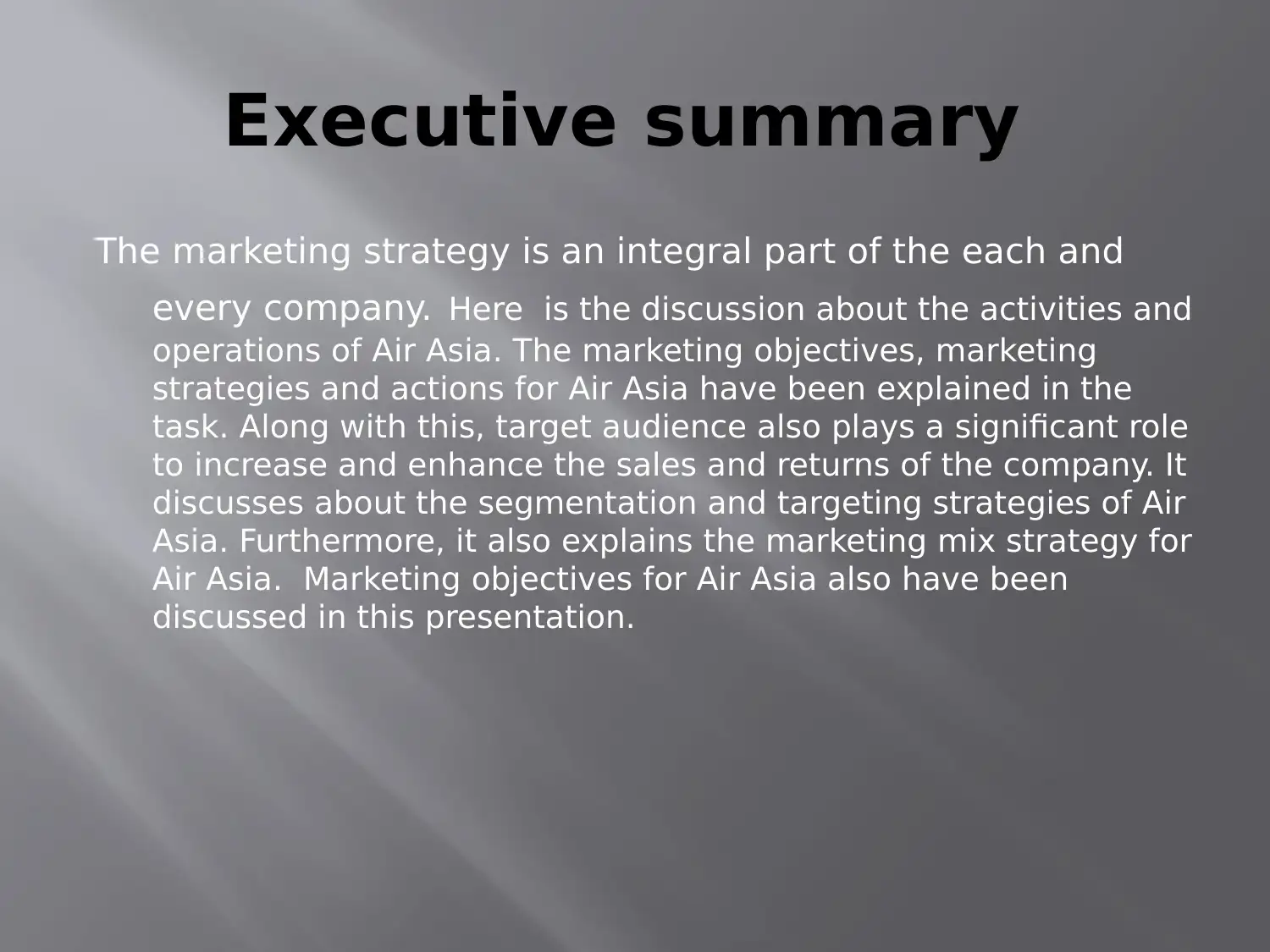
Executive summary
The marketing strategy is an integral part of the each and
every company. Here is the discussion about the activities and
operations of Air Asia. The marketing objectives, marketing
strategies and actions for Air Asia have been explained in the
task. Along with this, target audience also plays a significant role
to increase and enhance the sales and returns of the company. It
discusses about the segmentation and targeting strategies of Air
Asia. Furthermore, it also explains the marketing mix strategy for
Air Asia. Marketing objectives for Air Asia also have been
discussed in this presentation.
The marketing strategy is an integral part of the each and
every company. Here is the discussion about the activities and
operations of Air Asia. The marketing objectives, marketing
strategies and actions for Air Asia have been explained in the
task. Along with this, target audience also plays a significant role
to increase and enhance the sales and returns of the company. It
discusses about the segmentation and targeting strategies of Air
Asia. Furthermore, it also explains the marketing mix strategy for
Air Asia. Marketing objectives for Air Asia also have been
discussed in this presentation.
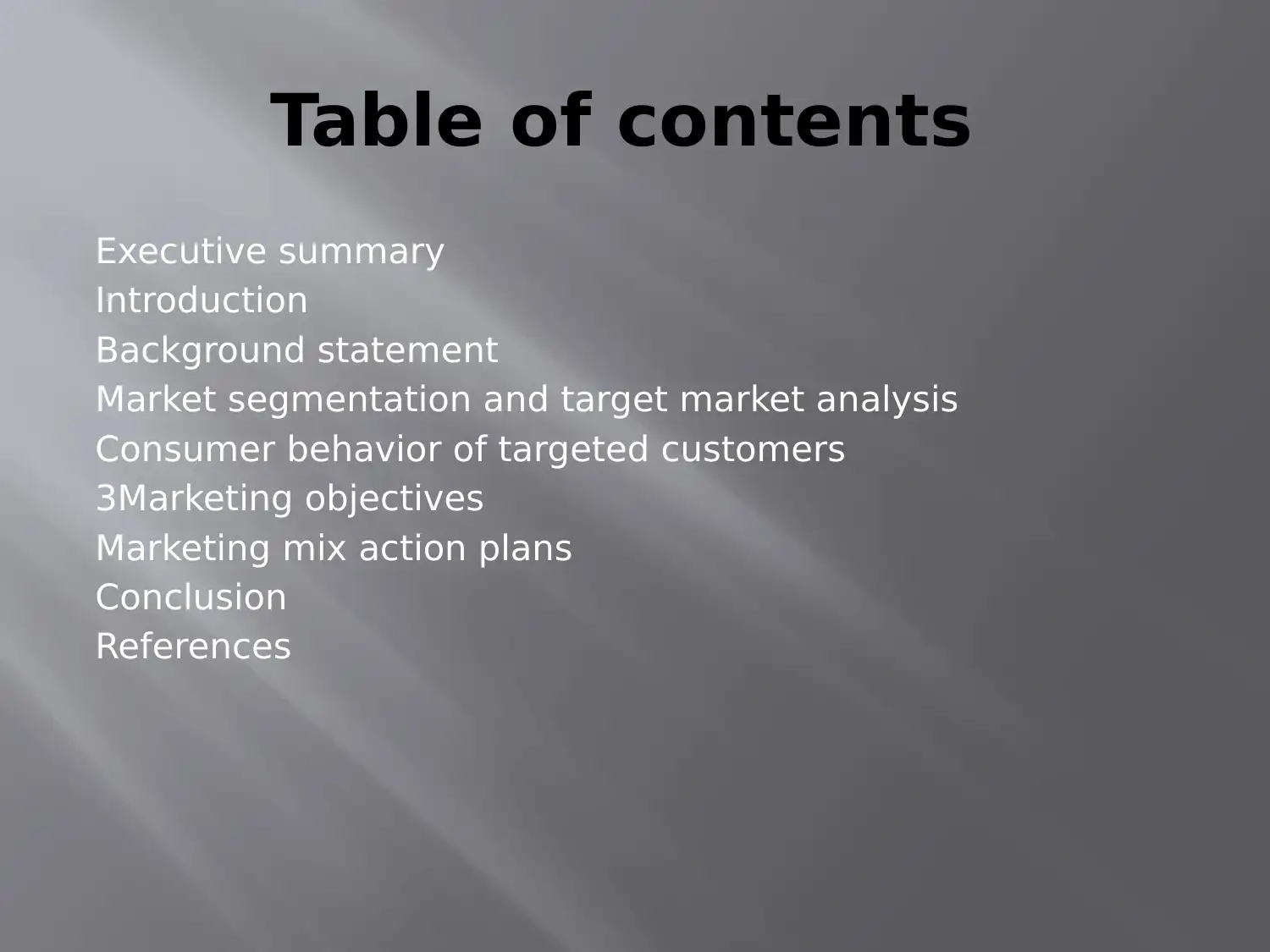
Table of contents
Executive summary
Introduction
Background statement
Market segmentation and target market analysis
Consumer behavior of targeted customers
3Marketing objectives
Marketing mix action plans
Conclusion
References
Executive summary
Introduction
Background statement
Market segmentation and target market analysis
Consumer behavior of targeted customers
3Marketing objectives
Marketing mix action plans
Conclusion
References
⊘ This is a preview!⊘
Do you want full access?
Subscribe today to unlock all pages.

Trusted by 1+ million students worldwide
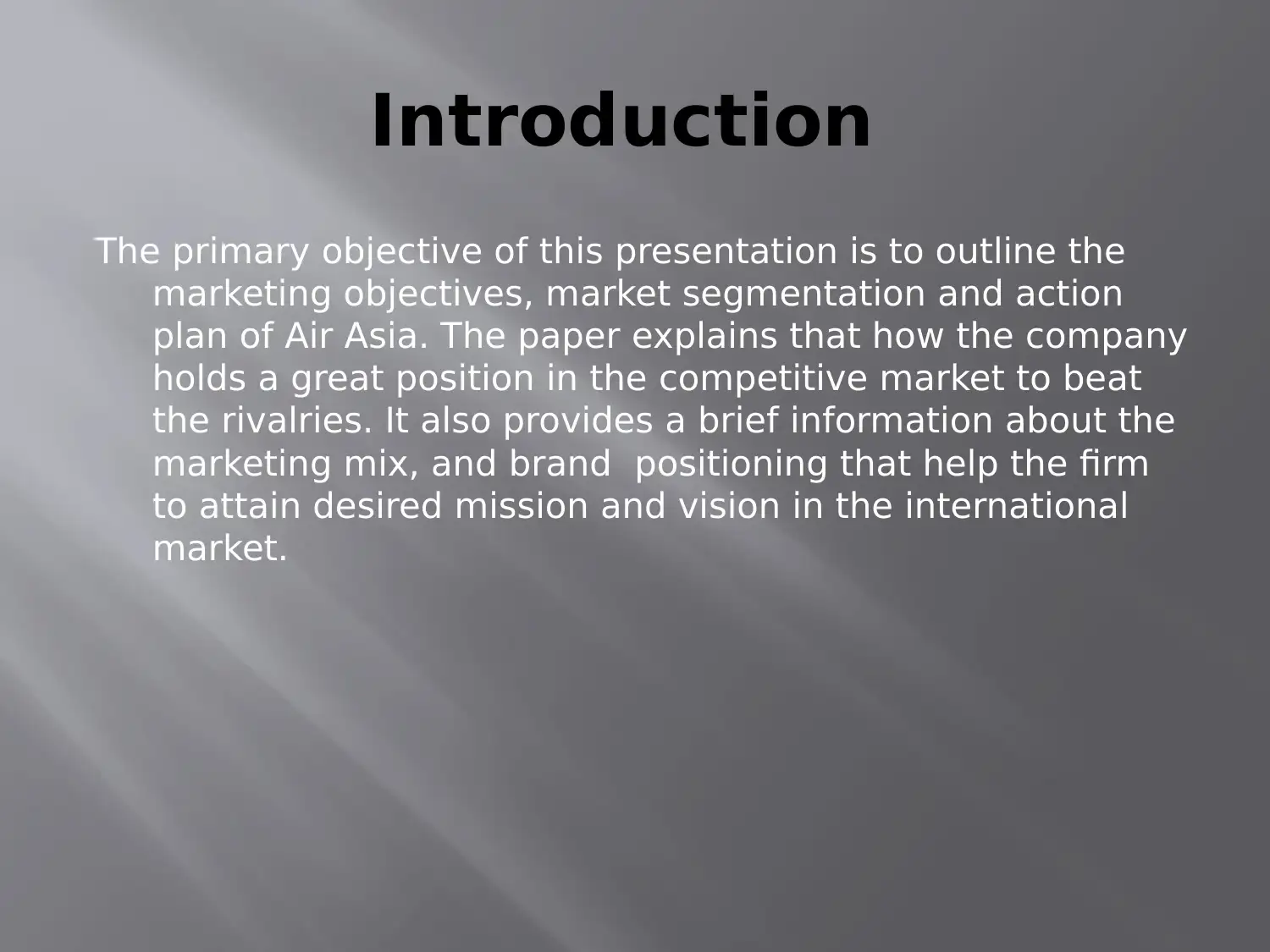
Introduction
The primary objective of this presentation is to outline the
marketing objectives, market segmentation and action
plan of Air Asia. The paper explains that how the company
holds a great position in the competitive market to beat
the rivalries. It also provides a brief information about the
marketing mix, and brand positioning that help the firm
to attain desired mission and vision in the international
market.
The primary objective of this presentation is to outline the
marketing objectives, market segmentation and action
plan of Air Asia. The paper explains that how the company
holds a great position in the competitive market to beat
the rivalries. It also provides a brief information about the
marketing mix, and brand positioning that help the firm
to attain desired mission and vision in the international
market.
Paraphrase This Document
Need a fresh take? Get an instant paraphrase of this document with our AI Paraphraser
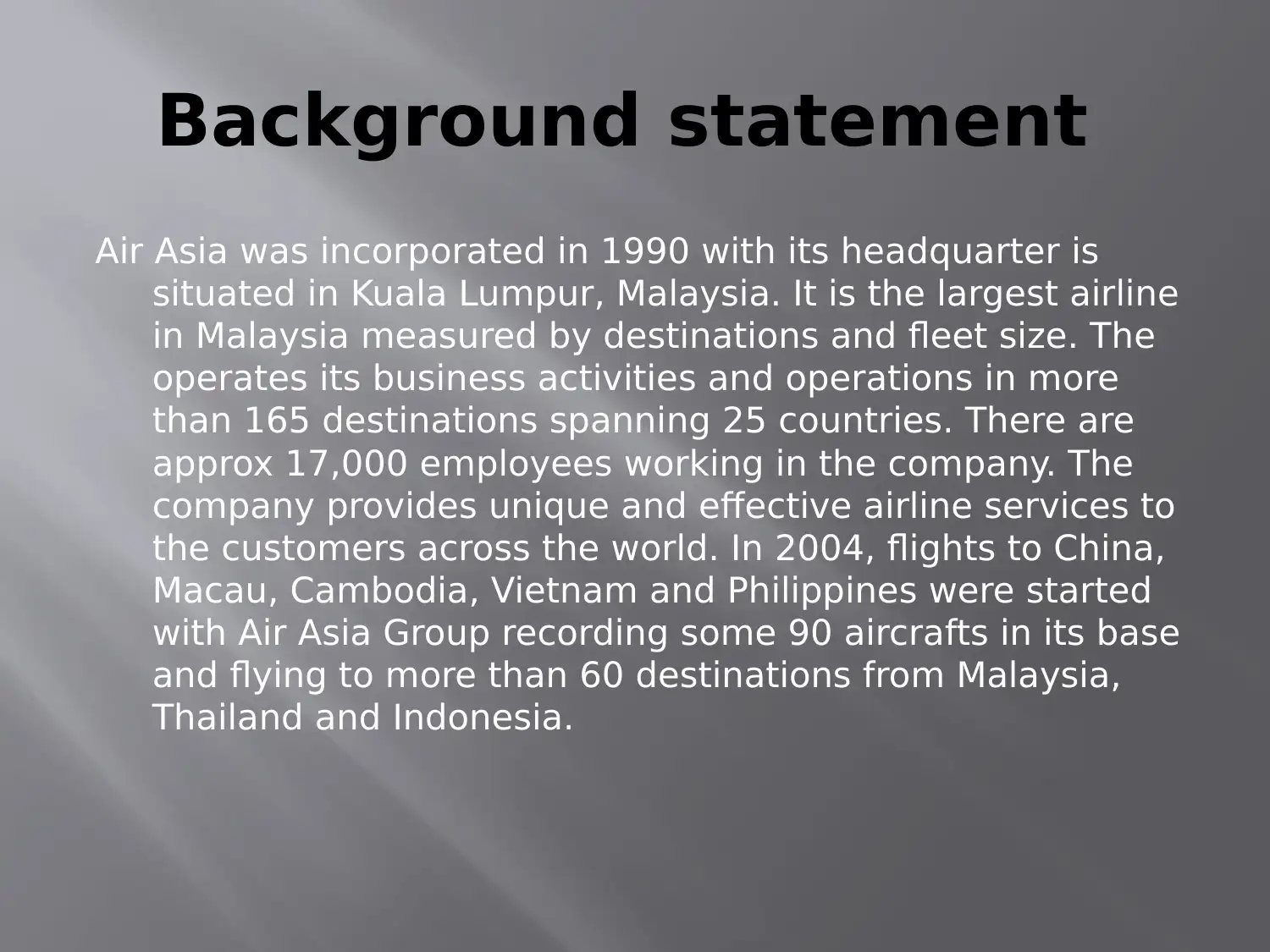
Background statement
Air Asia was incorporated in 1990 with its headquarter is
situated in Kuala Lumpur, Malaysia. It is the largest airline
in Malaysia measured by destinations and fleet size. The
operates its business activities and operations in more
than 165 destinations spanning 25 countries. There are
approx 17,000 employees working in the company. The
company provides unique and effective airline services to
the customers across the world. In 2004, flights to China,
Macau, Cambodia, Vietnam and Philippines were started
with Air Asia Group recording some 90 aircrafts in its base
and flying to more than 60 destinations from Malaysia,
Thailand and Indonesia.
Air Asia was incorporated in 1990 with its headquarter is
situated in Kuala Lumpur, Malaysia. It is the largest airline
in Malaysia measured by destinations and fleet size. The
operates its business activities and operations in more
than 165 destinations spanning 25 countries. There are
approx 17,000 employees working in the company. The
company provides unique and effective airline services to
the customers across the world. In 2004, flights to China,
Macau, Cambodia, Vietnam and Philippines were started
with Air Asia Group recording some 90 aircrafts in its base
and flying to more than 60 destinations from Malaysia,
Thailand and Indonesia.
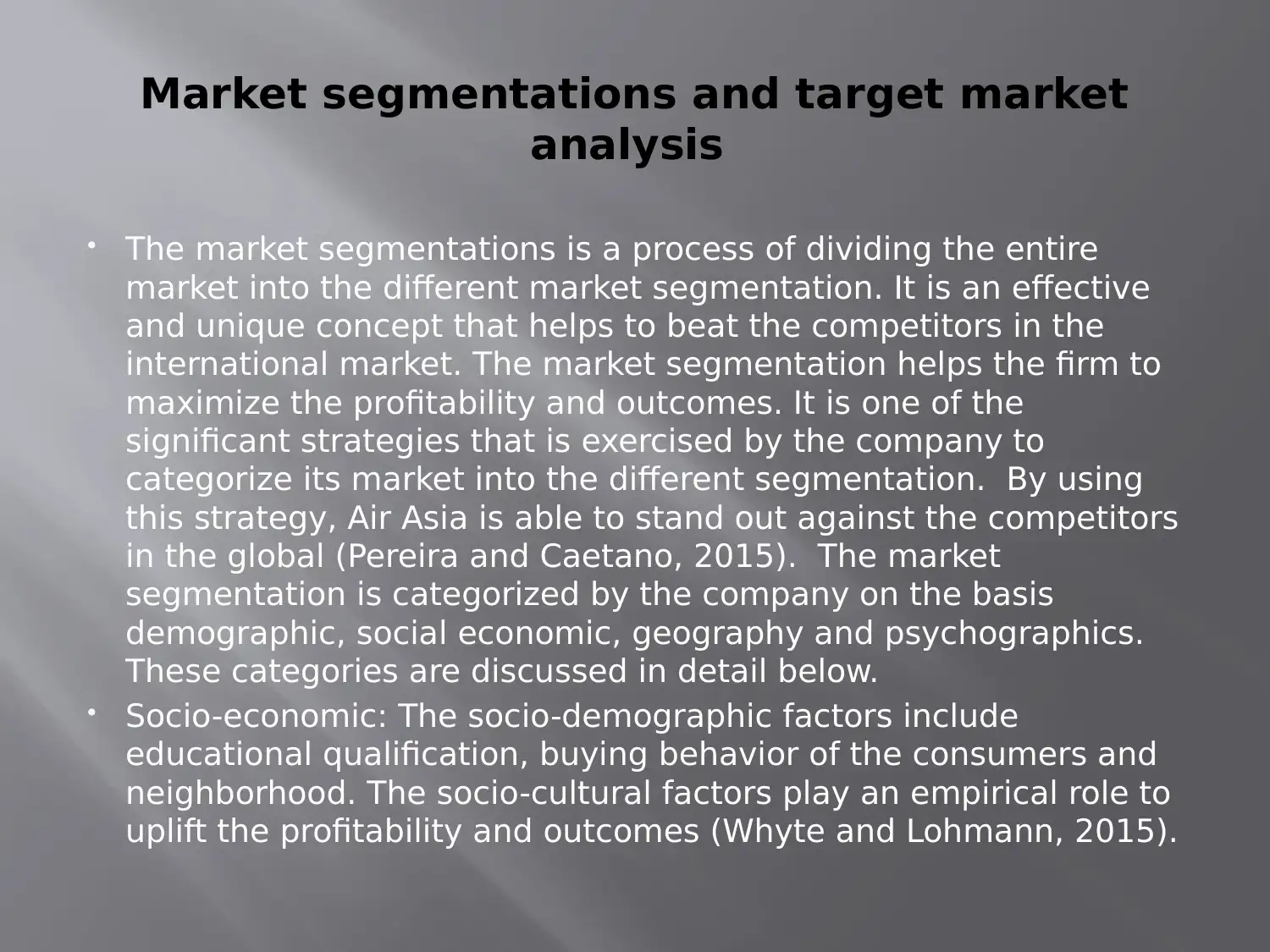
Market segmentations and target market
analysis
The market segmentations is a process of dividing the entire
market into the different market segmentation. It is an effective
and unique concept that helps to beat the competitors in the
international market. The market segmentation helps the firm to
maximize the profitability and outcomes. It is one of the
significant strategies that is exercised by the company to
categorize its market into the different segmentation. By using
this strategy, Air Asia is able to stand out against the competitors
in the global (Pereira and Caetano, 2015). The market
segmentation is categorized by the company on the basis
demographic, social economic, geography and psychographics.
These categories are discussed in detail below.
Socio-economic: The socio-demographic factors include
educational qualification, buying behavior of the consumers and
neighborhood. The socio-cultural factors play an empirical role to
uplift the profitability and outcomes (Whyte and Lohmann, 2015).
analysis
The market segmentations is a process of dividing the entire
market into the different market segmentation. It is an effective
and unique concept that helps to beat the competitors in the
international market. The market segmentation helps the firm to
maximize the profitability and outcomes. It is one of the
significant strategies that is exercised by the company to
categorize its market into the different segmentation. By using
this strategy, Air Asia is able to stand out against the competitors
in the global (Pereira and Caetano, 2015). The market
segmentation is categorized by the company on the basis
demographic, social economic, geography and psychographics.
These categories are discussed in detail below.
Socio-economic: The socio-demographic factors include
educational qualification, buying behavior of the consumers and
neighborhood. The socio-cultural factors play an empirical role to
uplift the profitability and outcomes (Whyte and Lohmann, 2015).
⊘ This is a preview!⊘
Do you want full access?
Subscribe today to unlock all pages.

Trusted by 1+ million students worldwide
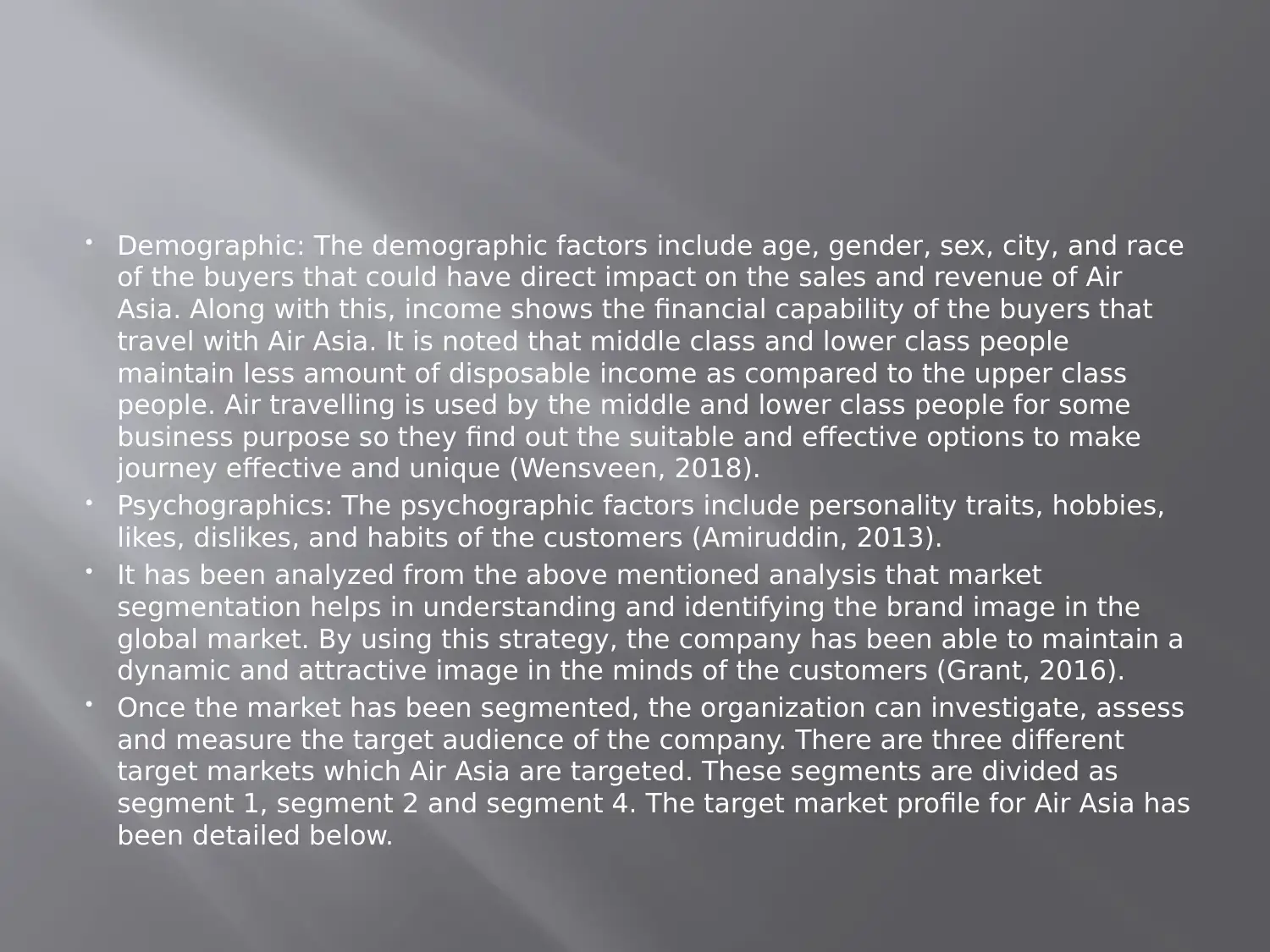
Demographic: The demographic factors include age, gender, sex, city, and race
of the buyers that could have direct impact on the sales and revenue of Air
Asia. Along with this, income shows the financial capability of the buyers that
travel with Air Asia. It is noted that middle class and lower class people
maintain less amount of disposable income as compared to the upper class
people. Air travelling is used by the middle and lower class people for some
business purpose so they find out the suitable and effective options to make
journey effective and unique (Wensveen, 2018).
Psychographics: The psychographic factors include personality traits, hobbies,
likes, dislikes, and habits of the customers (Amiruddin, 2013).
It has been analyzed from the above mentioned analysis that market
segmentation helps in understanding and identifying the brand image in the
global market. By using this strategy, the company has been able to maintain a
dynamic and attractive image in the minds of the customers (Grant, 2016).
Once the market has been segmented, the organization can investigate, assess
and measure the target audience of the company. There are three different
target markets which Air Asia are targeted. These segments are divided as
segment 1, segment 2 and segment 4. The target market profile for Air Asia has
been detailed below.
of the buyers that could have direct impact on the sales and revenue of Air
Asia. Along with this, income shows the financial capability of the buyers that
travel with Air Asia. It is noted that middle class and lower class people
maintain less amount of disposable income as compared to the upper class
people. Air travelling is used by the middle and lower class people for some
business purpose so they find out the suitable and effective options to make
journey effective and unique (Wensveen, 2018).
Psychographics: The psychographic factors include personality traits, hobbies,
likes, dislikes, and habits of the customers (Amiruddin, 2013).
It has been analyzed from the above mentioned analysis that market
segmentation helps in understanding and identifying the brand image in the
global market. By using this strategy, the company has been able to maintain a
dynamic and attractive image in the minds of the customers (Grant, 2016).
Once the market has been segmented, the organization can investigate, assess
and measure the target audience of the company. There are three different
target markets which Air Asia are targeted. These segments are divided as
segment 1, segment 2 and segment 4. The target market profile for Air Asia has
been detailed below.
Paraphrase This Document
Need a fresh take? Get an instant paraphrase of this document with our AI Paraphraser
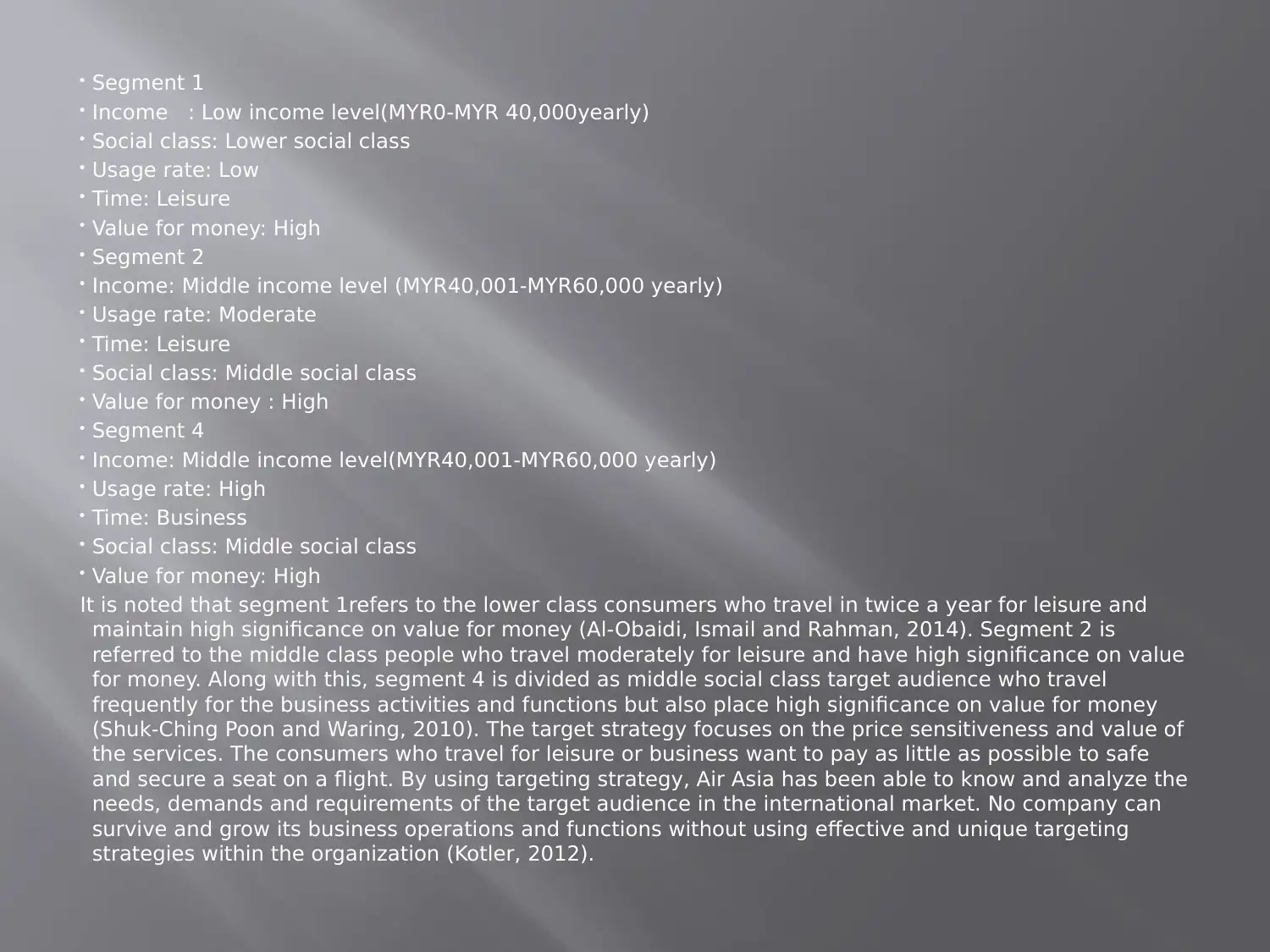
Segment 1
Income : Low income level(MYR0-MYR 40,000yearly)
Social class: Lower social class
Usage rate: Low
Time: Leisure
Value for money: High
Segment 2
Income: Middle income level (MYR40,001-MYR60,000 yearly)
Usage rate: Moderate
Time: Leisure
Social class: Middle social class
Value for money : High
Segment 4
Income: Middle income level(MYR40,001-MYR60,000 yearly)
Usage rate: High
Time: Business
Social class: Middle social class
Value for money: High
It is noted that segment 1refers to the lower class consumers who travel in twice a year for leisure and
maintain high significance on value for money (Al-Obaidi, Ismail and Rahman, 2014). Segment 2 is
referred to the middle class people who travel moderately for leisure and have high significance on value
for money. Along with this, segment 4 is divided as middle social class target audience who travel
frequently for the business activities and functions but also place high significance on value for money
(Shuk-Ching Poon and Waring, 2010). The target strategy focuses on the price sensitiveness and value of
the services. The consumers who travel for leisure or business want to pay as little as possible to safe
and secure a seat on a flight. By using targeting strategy, Air Asia has been able to know and analyze the
needs, demands and requirements of the target audience in the international market. No company can
survive and grow its business operations and functions without using effective and unique targeting
strategies within the organization (Kotler, 2012).
Income : Low income level(MYR0-MYR 40,000yearly)
Social class: Lower social class
Usage rate: Low
Time: Leisure
Value for money: High
Segment 2
Income: Middle income level (MYR40,001-MYR60,000 yearly)
Usage rate: Moderate
Time: Leisure
Social class: Middle social class
Value for money : High
Segment 4
Income: Middle income level(MYR40,001-MYR60,000 yearly)
Usage rate: High
Time: Business
Social class: Middle social class
Value for money: High
It is noted that segment 1refers to the lower class consumers who travel in twice a year for leisure and
maintain high significance on value for money (Al-Obaidi, Ismail and Rahman, 2014). Segment 2 is
referred to the middle class people who travel moderately for leisure and have high significance on value
for money. Along with this, segment 4 is divided as middle social class target audience who travel
frequently for the business activities and functions but also place high significance on value for money
(Shuk-Ching Poon and Waring, 2010). The target strategy focuses on the price sensitiveness and value of
the services. The consumers who travel for leisure or business want to pay as little as possible to safe
and secure a seat on a flight. By using targeting strategy, Air Asia has been able to know and analyze the
needs, demands and requirements of the target audience in the international market. No company can
survive and grow its business operations and functions without using effective and unique targeting
strategies within the organization (Kotler, 2012).
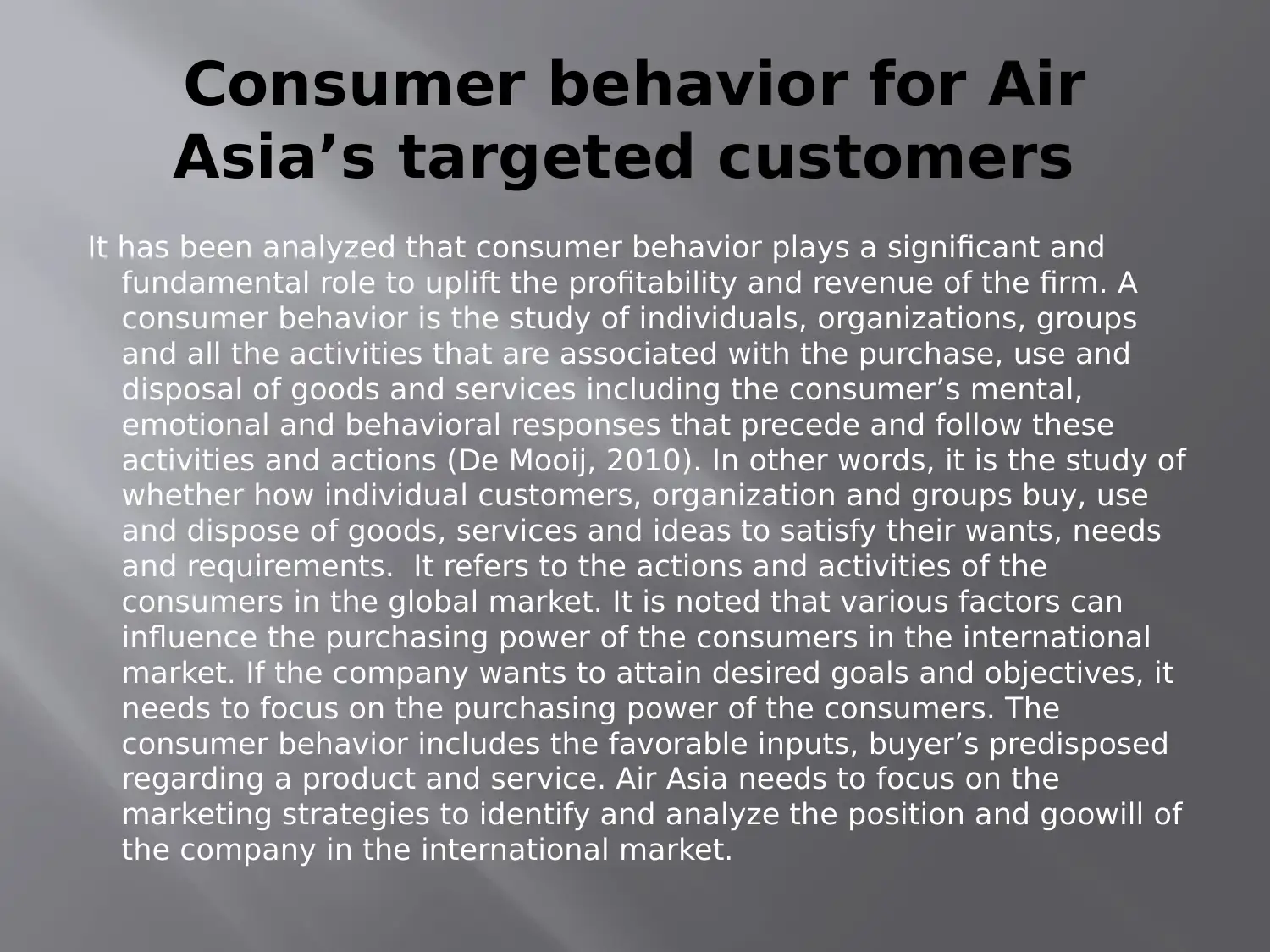
Consumer behavior for Air
Asia’s targeted customers
It has been analyzed that consumer behavior plays a significant and
fundamental role to uplift the profitability and revenue of the firm. A
consumer behavior is the study of individuals, organizations, groups
and all the activities that are associated with the purchase, use and
disposal of goods and services including the consumer’s mental,
emotional and behavioral responses that precede and follow these
activities and actions (De Mooij, 2010). In other words, it is the study of
whether how individual customers, organization and groups buy, use
and dispose of goods, services and ideas to satisfy their wants, needs
and requirements. It refers to the actions and activities of the
consumers in the global market. It is noted that various factors can
influence the purchasing power of the consumers in the international
market. If the company wants to attain desired goals and objectives, it
needs to focus on the purchasing power of the consumers. The
consumer behavior includes the favorable inputs, buyer’s predisposed
regarding a product and service. Air Asia needs to focus on the
marketing strategies to identify and analyze the position and goowill of
the company in the international market.
Asia’s targeted customers
It has been analyzed that consumer behavior plays a significant and
fundamental role to uplift the profitability and revenue of the firm. A
consumer behavior is the study of individuals, organizations, groups
and all the activities that are associated with the purchase, use and
disposal of goods and services including the consumer’s mental,
emotional and behavioral responses that precede and follow these
activities and actions (De Mooij, 2010). In other words, it is the study of
whether how individual customers, organization and groups buy, use
and dispose of goods, services and ideas to satisfy their wants, needs
and requirements. It refers to the actions and activities of the
consumers in the global market. It is noted that various factors can
influence the purchasing power of the consumers in the international
market. If the company wants to attain desired goals and objectives, it
needs to focus on the purchasing power of the consumers. The
consumer behavior includes the favorable inputs, buyer’s predisposed
regarding a product and service. Air Asia needs to focus on the
marketing strategies to identify and analyze the position and goowill of
the company in the international market.
⊘ This is a preview!⊘
Do you want full access?
Subscribe today to unlock all pages.

Trusted by 1+ million students worldwide
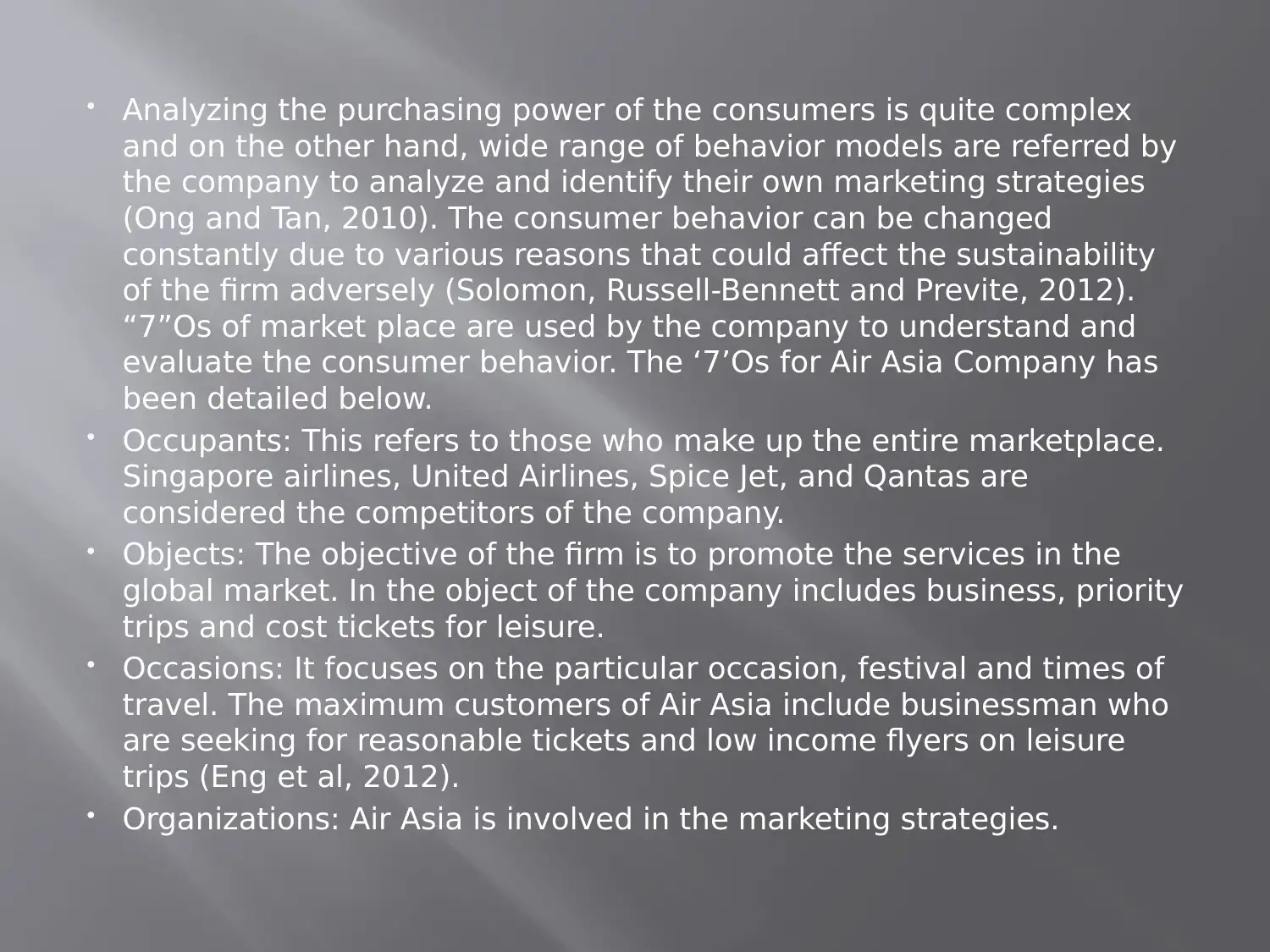
Analyzing the purchasing power of the consumers is quite complex
and on the other hand, wide range of behavior models are referred by
the company to analyze and identify their own marketing strategies
(Ong and Tan, 2010). The consumer behavior can be changed
constantly due to various reasons that could affect the sustainability
of the firm adversely (Solomon, Russell-Bennett and Previte, 2012).
“7”Os of market place are used by the company to understand and
evaluate the consumer behavior. The ‘7’Os for Air Asia Company has
been detailed below.
Occupants: This refers to those who make up the entire marketplace.
Singapore airlines, United Airlines, Spice Jet, and Qantas are
considered the competitors of the company.
Objects: The objective of the firm is to promote the services in the
global market. In the object of the company includes business, priority
trips and cost tickets for leisure.
Occasions: It focuses on the particular occasion, festival and times of
travel. The maximum customers of Air Asia include businessman who
are seeking for reasonable tickets and low income flyers on leisure
trips (Eng et al, 2012).
Organizations: Air Asia is involved in the marketing strategies.
and on the other hand, wide range of behavior models are referred by
the company to analyze and identify their own marketing strategies
(Ong and Tan, 2010). The consumer behavior can be changed
constantly due to various reasons that could affect the sustainability
of the firm adversely (Solomon, Russell-Bennett and Previte, 2012).
“7”Os of market place are used by the company to understand and
evaluate the consumer behavior. The ‘7’Os for Air Asia Company has
been detailed below.
Occupants: This refers to those who make up the entire marketplace.
Singapore airlines, United Airlines, Spice Jet, and Qantas are
considered the competitors of the company.
Objects: The objective of the firm is to promote the services in the
global market. In the object of the company includes business, priority
trips and cost tickets for leisure.
Occasions: It focuses on the particular occasion, festival and times of
travel. The maximum customers of Air Asia include businessman who
are seeking for reasonable tickets and low income flyers on leisure
trips (Eng et al, 2012).
Organizations: Air Asia is involved in the marketing strategies.
Paraphrase This Document
Need a fresh take? Get an instant paraphrase of this document with our AI Paraphraser
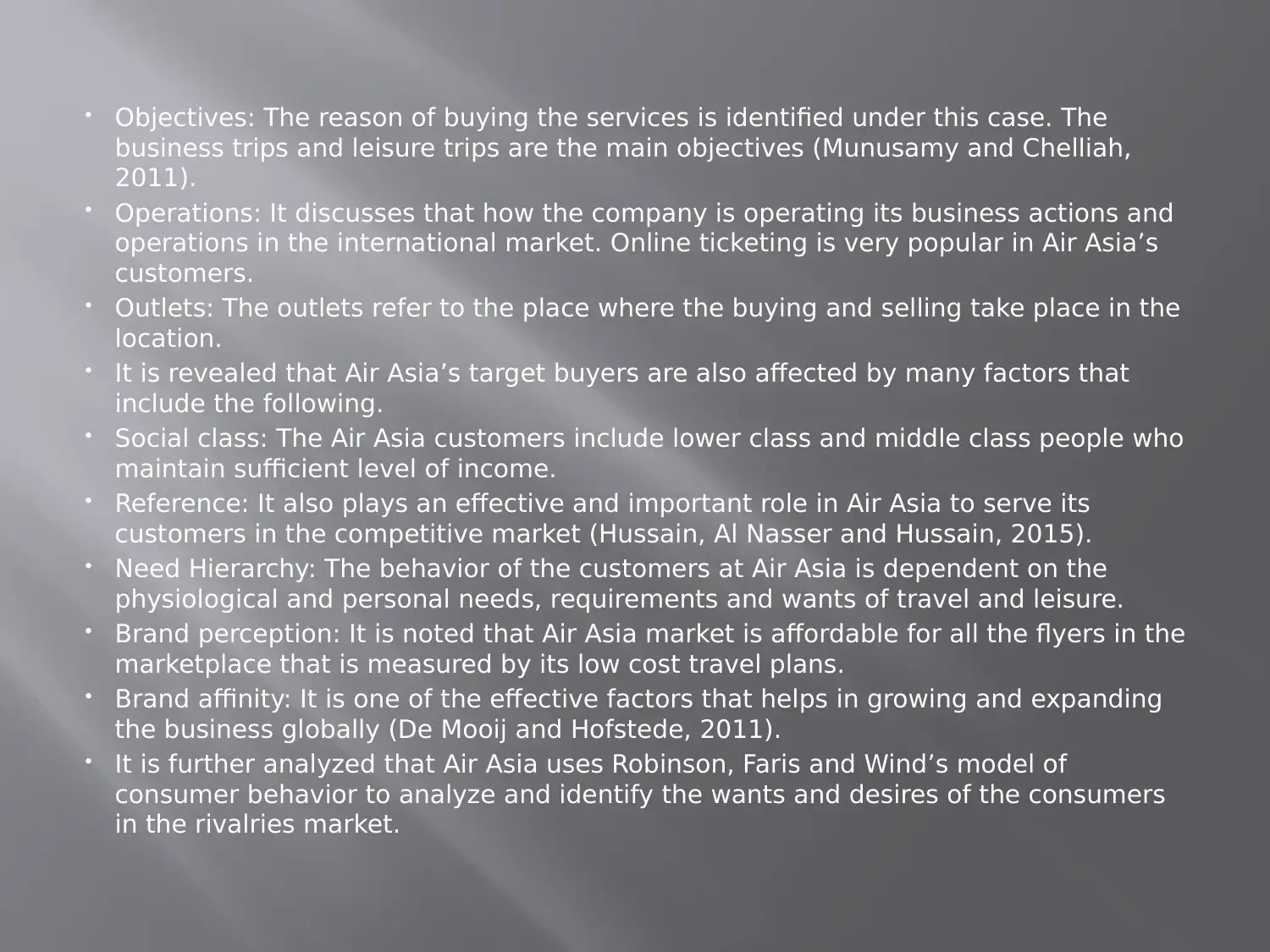
Objectives: The reason of buying the services is identified under this case. The
business trips and leisure trips are the main objectives (Munusamy and Chelliah,
2011).
Operations: It discusses that how the company is operating its business actions and
operations in the international market. Online ticketing is very popular in Air Asia’s
customers.
Outlets: The outlets refer to the place where the buying and selling take place in the
location.
It is revealed that Air Asia’s target buyers are also affected by many factors that
include the following.
Social class: The Air Asia customers include lower class and middle class people who
maintain sufficient level of income.
Reference: It also plays an effective and important role in Air Asia to serve its
customers in the competitive market (Hussain, Al Nasser and Hussain, 2015).
Need Hierarchy: The behavior of the customers at Air Asia is dependent on the
physiological and personal needs, requirements and wants of travel and leisure.
Brand perception: It is noted that Air Asia market is affordable for all the flyers in the
marketplace that is measured by its low cost travel plans.
Brand affinity: It is one of the effective factors that helps in growing and expanding
the business globally (De Mooij and Hofstede, 2011).
It is further analyzed that Air Asia uses Robinson, Faris and Wind’s model of
consumer behavior to analyze and identify the wants and desires of the consumers
in the rivalries market.
business trips and leisure trips are the main objectives (Munusamy and Chelliah,
2011).
Operations: It discusses that how the company is operating its business actions and
operations in the international market. Online ticketing is very popular in Air Asia’s
customers.
Outlets: The outlets refer to the place where the buying and selling take place in the
location.
It is revealed that Air Asia’s target buyers are also affected by many factors that
include the following.
Social class: The Air Asia customers include lower class and middle class people who
maintain sufficient level of income.
Reference: It also plays an effective and important role in Air Asia to serve its
customers in the competitive market (Hussain, Al Nasser and Hussain, 2015).
Need Hierarchy: The behavior of the customers at Air Asia is dependent on the
physiological and personal needs, requirements and wants of travel and leisure.
Brand perception: It is noted that Air Asia market is affordable for all the flyers in the
marketplace that is measured by its low cost travel plans.
Brand affinity: It is one of the effective factors that helps in growing and expanding
the business globally (De Mooij and Hofstede, 2011).
It is further analyzed that Air Asia uses Robinson, Faris and Wind’s model of
consumer behavior to analyze and identify the wants and desires of the consumers
in the rivalries market.
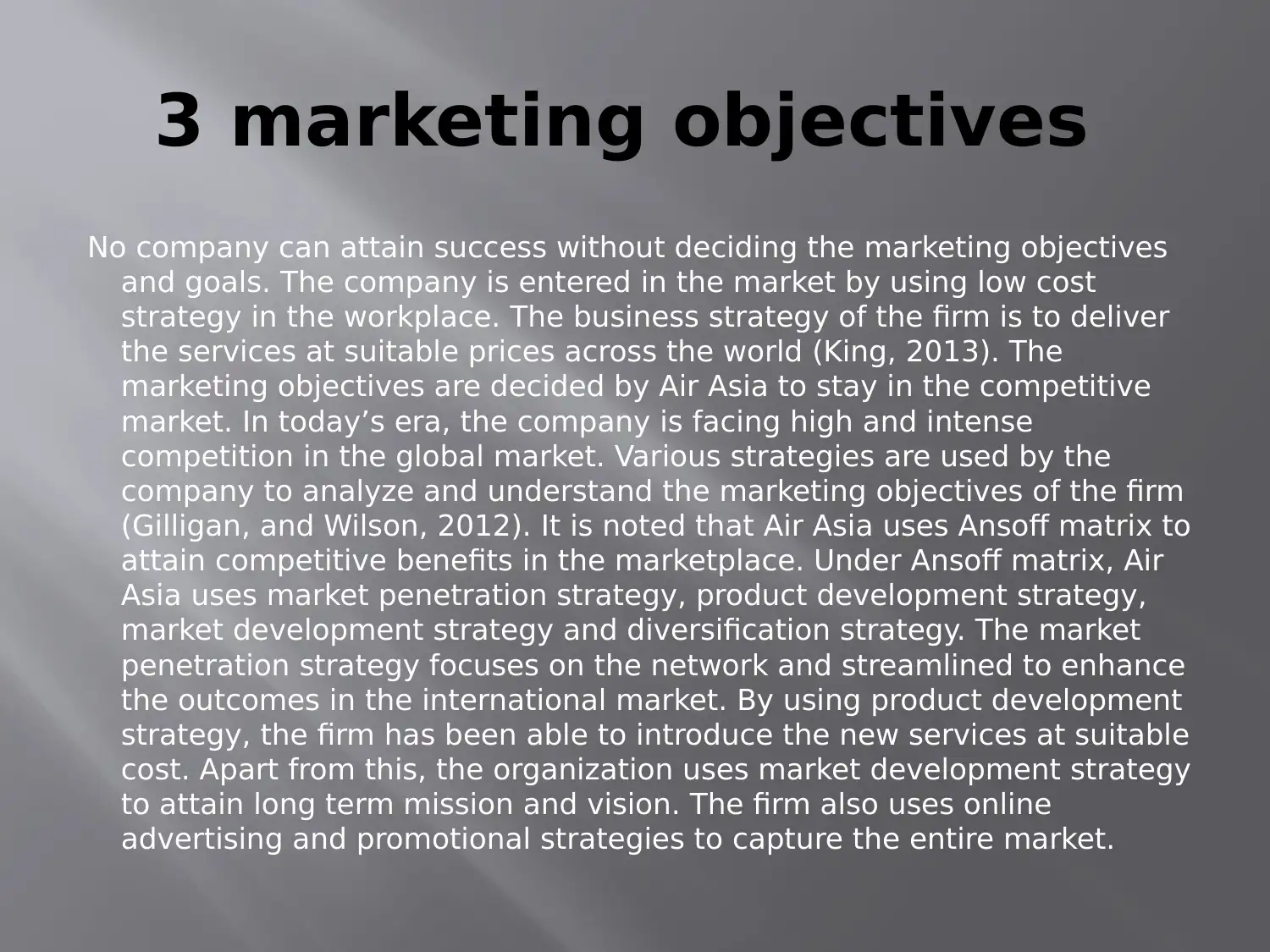
3 marketing objectives
No company can attain success without deciding the marketing objectives
and goals. The company is entered in the market by using low cost
strategy in the workplace. The business strategy of the firm is to deliver
the services at suitable prices across the world (King, 2013). The
marketing objectives are decided by Air Asia to stay in the competitive
market. In today’s era, the company is facing high and intense
competition in the global market. Various strategies are used by the
company to analyze and understand the marketing objectives of the firm
(Gilligan, and Wilson, 2012). It is noted that Air Asia uses Ansoff matrix to
attain competitive benefits in the marketplace. Under Ansoff matrix, Air
Asia uses market penetration strategy, product development strategy,
market development strategy and diversification strategy. The market
penetration strategy focuses on the network and streamlined to enhance
the outcomes in the international market. By using product development
strategy, the firm has been able to introduce the new services at suitable
cost. Apart from this, the organization uses market development strategy
to attain long term mission and vision. The firm also uses online
advertising and promotional strategies to capture the entire market.
No company can attain success without deciding the marketing objectives
and goals. The company is entered in the market by using low cost
strategy in the workplace. The business strategy of the firm is to deliver
the services at suitable prices across the world (King, 2013). The
marketing objectives are decided by Air Asia to stay in the competitive
market. In today’s era, the company is facing high and intense
competition in the global market. Various strategies are used by the
company to analyze and understand the marketing objectives of the firm
(Gilligan, and Wilson, 2012). It is noted that Air Asia uses Ansoff matrix to
attain competitive benefits in the marketplace. Under Ansoff matrix, Air
Asia uses market penetration strategy, product development strategy,
market development strategy and diversification strategy. The market
penetration strategy focuses on the network and streamlined to enhance
the outcomes in the international market. By using product development
strategy, the firm has been able to introduce the new services at suitable
cost. Apart from this, the organization uses market development strategy
to attain long term mission and vision. The firm also uses online
advertising and promotional strategies to capture the entire market.
⊘ This is a preview!⊘
Do you want full access?
Subscribe today to unlock all pages.

Trusted by 1+ million students worldwide
1 out of 21
Related Documents
Your All-in-One AI-Powered Toolkit for Academic Success.
+13062052269
info@desklib.com
Available 24*7 on WhatsApp / Email
![[object Object]](/_next/static/media/star-bottom.7253800d.svg)
Unlock your academic potential
Copyright © 2020–2025 A2Z Services. All Rights Reserved. Developed and managed by ZUCOL.




